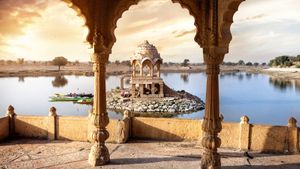Bihar is a major tourist destination in north India. However, not many people are aware of the various tourist wonders that exist in Bihar. Did you know that Bihar is one of the oldest inhabited places in the world, with over 3,000 years of history in the state? To help you learn more and possibly encourage you to plan your next trip to Bihar, here are the best tourist places in Bihar that you must visit on your next trip.
Bodhgaya
If one were to visit just a single sacred site related to any Buddhist tradition, Bodh Gaya would be it. It was here, beneath the Bodhi Tree and the light of the full moon, that Shakyamuni Buddha awakened to the ultimate nature of reality, resulting in the diverse forms of Buddhism we now see throughout the world. A bodhi tree and a beautifully carved stone temple, the Mahabodhi Temple, mark the site known as the “Vajra Seat.” As well as being the site of the Buddha’s great awakening, this is also where every Buddha of the past and future has and will attain Buddhahood. As such, it is considered the geographic heart of Buddhism. Like Lumbini, Bodh Gaya features monasteries from every Buddhist tradition in Asia.
Nalanda
Nalanda Archaeological Site located in the state of Bihar is considered to be one of the oldest universities in the world where you can see many famous artefacts in stupas and viharas, archaeological remains of a Mahavihara or Buddhist monastery. The origin of the educational institution at Nalanda dates back to the 5th century AD and served as a highly recognized seat of learning for an uninterrupted period of 800 years. It is a UNESCO World Heritage Site. It is also a testimony to the development of Buddhism as a religion. Nalanda was considered an architectural masterpiece which is spread over an area of 23 hectares. Covered by a high wall and a massive gate, the institution consisted of several temples, viharas (educational and residential buildings), compounds, stupas, classrooms and meditation halls.
Patna Museum
The state museum of Bihar, established in 1917 by the British government, was built to display historical and archaeological artefacts documenting the history of Bihar after its partition from Bengal in 1912. It currently includes in its collection paintings, textiles, bronze and terracotta sculptures, manuscripts, as well as fossils and relics.
Rohtas Fort
The Rohtas Fort is a symbol of the illustrious past of the Sone Valley. People during the initiative discussed their ancestors who did not have the benefits of modern technology and science and still could build such a marvellous fort at 1500 ft above sea level. The fort of Rohtas was won over by Sher Shah Suri from a Hindu king by deceit, and the gain of this fort made him very strong. It was only after winning Rohtas that he could gradually conquer the seat of Delhi. Sher Shah was so impressed by the magnificence of the Rohtas Fort, that he made a similar fort with the same name on the banks of the Jhelum in present Pakistan. The Pakistani Rohtas Fort is included in the UNESCO list of world heritage sites.
Mahatma Gandhi Setu
Mahatma Gandhi Setu, also known as the Gandhi Setu or the Ganga Setu, is a magnificent bridge spanning the mighty River Ganges in Bihar, connecting the capital city of Patna to Hajipur. It stands as one of the longest river bridges in India and has been an integral part of the region's transportation network since its completion in 1982. The bridge was conceived as a visionary project to address the growing need for a reliable and efficient transportation link between the two cities, which are important centres of commerce, culture, and administration in Bihar. The construction of Mahatma Gandhi Setu aimed to bolster economic activities, improve connectivity, and enhance the overall quality of life for the region's residents. This engineering marvel stretches over approximately 5.7 kilometres (3.5 miles) and comprises 45 spans, with a unique design that combines road and railway tracks. The bridge features a dual-carriageway, allowing for smooth vehicular movement, and also accommodates a railway line, which adds to its utility and efficiency.
Padri Ki Haveli
Famously called Padri-Ki-Haveli or 'Mansion of Padre', this is the oldest of Bihar state’s St Mary's Church. Today’s Padri-ki-Haveli is a place where some Roman Catholics arrived for the first time in Bihar and founded this tiny church in the year 1713. The then Venetian architect Tirreto redesigned the structure of the current church in 1772 upon his arrival here from Kolkata with an intention for its redesigning. This church’s foundation stone is on a huge location consisting of 70 feet long, 40 feet wide and a height of 50 feet that made it an enormous building. A quarrel between Nawab Mir Qasim and British traders on June 25, 1763, proved a bad omen for this church which got destroyed by the former. It was a huge loss as several ancient records were burnt away and destroyed at that time. Some more consequent damages to this church were done during the Great Indian Rebellion in the year 1857. The existing church today is a notable monument and is considered an architectural beauty. Several key details are still available in it which only a few Indian churches witness nowadays.
Photo: Shutterstock




